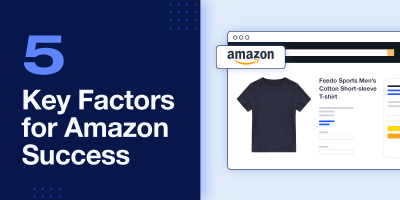Online shopping was already a growing trend in recent years, but it has spiked sharply due to the pandemic. As more people get used to the convenience of online shopping, we expect them to continue long after restrictions are lifted. By now, you probably recognize the importance of listing your products online, and the tremendous opportunity and reach that eCommerce offers. Online marketplaces like Amazon, Walmart, eBay, Google Shopping Actions, Target Plus, Facebook, and others, allow third-party sellers to list products and tap into a large network of shoppers.
If you’re new to eCommerce, or you’ve only sold products on your own website and never listed your products on a marketplace, becoming a third-party seller can feel complicated. We’ll help you understand marketplaces in a nutshell, and offer tips for what you’ll need to get started and succeed.
How does a marketplace work?
Marketplaces mostly make their money by charging commissions on a sale, in addition to offering sponsored ads or store subscriptions. Commission rates vary depending on the category of the product you’re selling, unless the marketplace charges a single commission rate across all sales. Some marketplaces also charge listing fees for each SKU they host on their site, or subscription fees for a professional seller account. A few marketplaces, like Google Shopping Actions and Facebook Marketplace, are currently waiving their commission fees.
When a customer purchases your product on a marketplace, the transaction takes place directly through the marketplace site. In order for you to receive payouts, most marketplaces require that you link your bank account to your seller account. This allows the marketplace to deposit payments into your account, minus any fees or commissions.
Marketplaces seek to provide customers with a uniform buying experience. As a result, marketplaces expect third-party sellers to meet specific requirements and performance metrics. Sellers who consistently have good performance metrics on a marketplace may receive special perks (like advertising credits or badges), and sellers who perform poorly (late shipments, lots of cancelled orders, damaged items) may have their accounts suspended. The specific requirements vary across marketplaces.
Fulfilling orders properly is a major part of meeting marketplace seller standards, and also has a big impact on the customer experience. If you fulfill orders manually, it can be an arduous process. To process a marketplace order, you need to log into the seller portal and provide a tracking number and carrier information. The marketplace then updates the customer that their order has been shipped. If you need to cancel an order or confirm a refund, you also need to do that through the marketplace seller portal.
With a high volume of orders (which you definitely want!) across multiple marketplaces, it can become very tedious to take action on all of your orders in time. However, if you use a feed management solution like Feedonomics, you can integrate your ecommerce platform or website with the marketplace seller portal. Feedonomics collects your order data from the marketplace and inserts it into your central ecommerce platform or website as if it were a native order. Once you process the order as usual, Feedonomics picks up the tracking information from your eCommerce platform and reports it back to the marketplace.

Listing products and selling them on marketplaces can be very exciting. Expanding your business is challenging, yet rewarding when done well. Before you make the jump to selling products on a marketplace, take the following steps to set yourself up for success.
- Track accurate inventory/stock quantities.
Syncing your inventory to the marketplace frequently and keeping the stock quantities up-to-date is crucial for avoiding overselling. Overselling occurs when a customer is able to successfully place an order for a product that you no longer have in stock. You would need to cancel the order, which would be a negative experience for that customer. Overselling too often can result in account suspension.
- Provide multiple high-quality images.
When it comes to online shopping, product images have a lot of impact on purchase decisions. Familiarize yourself with the marketplace’s image requirements to make sure you can list products. Most major marketplaces require a high-resolution main image of the product by itself on a white background. The majority of marketplaces don’t allow markup, line sheets, graphics, or watermarks on the images.
Additional product images showing different angles are important. Larger images show more detail, which can boost your sales. You also want to include lifestyle images that show your product in use, so customers can imagine the value they’d get from your product.
- Include GTINs or UPCs.
Most major marketplaces, including Amazon, Walmart, and Target Plus, require a unique product identifier, like a GTIN, UPC, EAN, or ISBN. Including UPCs in your listings helps your products appear in search engines, and can make it easier for shoppers to find items related to their queries. If you don’t have UPCs, you can often apply for an exemption on the marketplace if you are the brand owner.
- Leverage your product descriptions and bullet points.
Online shoppers are trying to make decisions based on the information you provide, since they cannot hold the product in their hands before a purchase. It seems obvious, but make sure your descriptions are written with your customers in mind. Write with a B2C mindset, not a B2B mindset. Try to answer the questions that users might be asking themselves before they make a purchase.
Buyers often see the bullet points before they see the full description. Bullet points can list the most important selling points or features at a glance, so make sure you’re thinking about how to use this valuable real estate to make your product stand out. Identify what sets your product apart and highlight it for your audience.
- Have your shipping weights and dimensions available.
Marketplaces require this information to calculate shipping costs for the customer. It’s becoming more common for a marketplace to require this information in a product listing, so make sure you know where and how to get it.
- Take advantage of being the brand owner.
If you’re the manufacturer or brand owner of a product line, you can often register your brand on a given marketplace and receive certain perks. For example, on Amazon, brand owners have more control of their product data—even if approved resellers are listing the same products—and can create a customized storefront with custom text, videos, images, and product pages. GTIN or UPC exemptions are sometimes available to brand owners as well. To register as a brand owner, you need to provide proof of brand ownership, which can include a valid trademark registration.
- Optimize your product titles.
Although every marketplace can have slightly different requirements for product titles, like the character count limit, best practices are fairly common across all marketplaces. Your product titles should be consistent and provide useful product information that doesn’t come across as spammy. Most marketplaces recommend providing your brand, make, and model, as well as any relevant information about size, color, and material in the title.
We also suggest including product nouns that customers often query. For example, “Nike Air Precision III basketball shoe” could be a more relevant search title than “Nike Air Precision III” for shoppers who search for something like “Nike air basketball shoe.” Optimizing your product titles for each marketplace channel can be a lot of work, especially if you have thousands of SKUs, but using a product listing partner like Feedonomics can simplify the process and also ensure you’re applying best practices of multiple marketplace platforms.
- Find the right integration partners.
Connecting your systems and adding new channels into the mix can be daunting. It’s especially challenging if you’re on a legacy system, or your site uses a custom-built platform for products. For larger businesses, it’s not uncommon that product data, warehouse data (like stock quantities), and order fulfillment data are all housed in different locations. Getting everything to sync correctly requires proper scoping, testing, and in some cases, custom development. When you’re dealing with complex integrated systems, the goal should be to automate as much as possible, and streamline the process to avoid costly delays in data syncing.
- Plan ahead and give yourself enough time to discover what works.
Very few sellers can start listing products on a marketplace and immediately generate a high volume of sales. Well-known brands are able to do this, but other sellers need some time to gain sales traction. It’s a learning process, and the only way to really learn what works is to gain some experience. We recommend getting started early and making adjustments over time.
Manufacturers that have a high volume of orders, or need a flexible solution for optimizing large product catalogs, can struggle to find a feed management platform that meets their needs. For this reason, Feedonomics provides more than just a powerful feed management platform for product listing and order syncing. Our marketplace specialists handle complex integrations, data optimizations tailored to different channels, error resolution, and more. With 24/7 support available, you can focus on your day-to-day business operations while our feed specialists become an extension of your team. Find out how our marketplace solution can help your business!

Brian Roizen is the Cofounder and Chief Architect of Feedonomics, a full-service feed optimization platform that optimizes product data for hundreds of channels. He has been featured on numerous podcasts and eCommerce webinars, and regularly contributes to Search Engine Land and other industry-leading blogs. Brian graduated summa cum laude from UCLA with both a Bachelor’s and Master’s degree in Mechanical Engineering.



